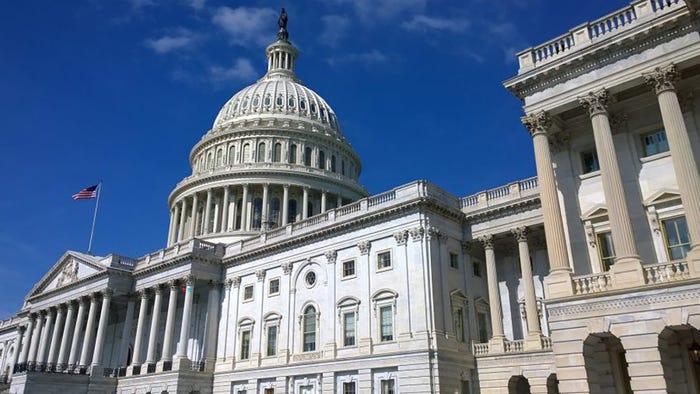FirstNet Authority board approves $218 million investment into 5G core, deployable assetsFirstNet Authority board approves $218 million investment into 5G core, deployable assets

FirstNet Authority board members yesterday voted to approve its first network investments into the nationwide public-safety broadband network (NPSBN)—a total of $218 million that will be used to fund initial upgrades to help make the FirstNet core ready for 5G, as well as to expand FirstNet’s portfolio of deployable network assets.
With the vote, FirstNet Authority leadership is expected to issue task orders to AT&T—the FirstNet contractor charged with building and maintaining the public-safety network—for the core upgrade and the additional deployable assets. Monetary details about the proposed expenditures were not shared during the board meeting, but sources indicated that most of the investment money will be used for the upgrades necessary to ready the network core to support 5G in the future.
FirstNet Authority Chairman Ed Horowitz described the investment approval as “marking a significant achievement for the network.” The areas of network investment were identified last September and the funding was available, but significant work was required at many levels to establish a process for actually taking such action for the first time, he said.
“Saying something and doing something are very different. But once again, [as] we have demonstrated over the years, we are doing what we said we would do,” Horowitz said during the board meeting, which was held via teleconference. “This was our first time doing this—setting up a process that will guide network investments for many years to come, and we have to get it right. And we feel we did.”
Horowitz applauded the efforts of FirstNet Authority staff leadership, as well as personnel in the National Telecommunications and Information Administration (NTIA) and the U.S. Department of Commerce (DoC) for allowing the long-held vision of FirstNet Authority network investments to become a reality.
“If there is anything that has come out of the diligence that has taken place and the effort that has taken place—over and above where we’re going to put the monies—is that the process that has been used to get to this point in all avenues is documented as repeatable,” Horowitz said.
“As time goes on, future boards should look back at this moment in time and say, ‘Boy, that was easy. It’s easy to make investments.’ And the only reason that is, is because of efforts that have taken place up to now by the [FirstNet Authority] management, NTIA, DoC and this board. I just want to say thank you very much for all of this.”
Horowitz has said that FirstNet Authority network investments could be executed through either an open procurement process or a task order to AT&T. Most observers expected these initial network investments—particularly the core upgrade—to be done via task order, but sources indicate that open procurements remain an option for future investments, depending on the circumstances.
Exactly when the FirstNet Authority will issue the task orders was not announced, but sources familiar with the matter indicated that it could happen as early as this week.
“We’re ready to get to work,” according to an AT&T statement provided to IWCE’s Urgent Communications. “When the FirstNet Authority staff executes the task order we’ll begin implementation. We expect to have the new deployables available next year.”
Currently, the FirstNet portfolio of deployable assets consists of 72 SatCOLTs, an LTE blimp, and three LTE drones, which are also called “flying COWs.” These are available—at no additional cost—to FirstNet subscribers to support both emergency-response efforts and connectivity needs during planned events that attract large crowds.
Many first responders have described the availability of the deployable assets as one of the most attractive benefits of subscribing to FirstNet service, which is a prime reason it was a target for the FirstNet Authority’s initial round of network investments.
“The deployables are getting tremendous usage for both planned and unplanned events,” Horowitz said. “They are changing the operational tempo on the ground. They are required to show up … in 14 hours or less, and they have done so many times—over and over—this past year. So, it’s logical to extend the capability in the deployable arena.”
During the meeting, there was no announcement about the scope of the deployment expansion, but AT&T provided some insights in response to an inquiry from IWCE’s Urgent Communications.
“We’re planning to expand the number of original 72 dedicated portable cell sites [SatCOLTs], while also bringing public-safety agencies new types of assets for their response efforts,” according to a prepared statement from an AT&T spokesperson. “We are not going into the specific number of deployables at this time.”
However, most of the $218 million in network investment will be used to fund initial upgrades to the FirstNet dedicated network core that eventually will allow the public-safety broadband system to support 5G services in the future.
Neil Cox, chairman of the FirstNet Authority board’s Technology Committee, said 5G promises faster data rates and lower latencies—a key characteristic, particularly for some critical EMS applications—as well as access to new services in the future.
“With 5G, we get access to new spectrum, which brings more and more capacity to improve the throughput,” Cox said during the board meeting. “These 5G features will mean a lot more devices—devices that are yet to come. We’ve got the whole Internet of Things that is going happen throughout the world—things like biometric sensors, motion detectors, … high-speed cameras and many other things that are unimaginable to us today.
“So, the action we are taking today to ensure that public safety is able to take advantage of all the potential that 5G has, when it’s ready for use by public safety.”
While this investment in the FirstNet network core is designed to prepare the public-safety broadband system to offer 5G capabilities in the future, officials for both the FirstNet Authority and AT&T have emphasized that most network functions will continue to leverage 4G LTE technology for years.
“The benefit of this initial upgrade is that FirstNet users will maintain access to LTE—Band 14, plus all of AT&T’s LTE bands—with priority and preemption, while also gaining access to AT&T’s 5G spectrum,” according to an AT&T statement provided to IWCE’s Urgent Communications.
“FirstNet users will maintain priority and preemption on LTE. This is always on, with no action necessary from the user. As it does today, the FirstNet network will intuitively manage public-safety traffic so that public safety has the best user experience—sending the data via the fastest route. That could be 5G, or it could be LTE, with priority and preemption. Either way, priority and preemption on FirstNet will always be there when public safety needs it.”
Under the 2012 law that established the FirstNet Authority, the FirstNet system is supposed to be a financially self-sustaining network, even though Congress provided just $7 billion for a project that experts estimated would cost more than $50 billion to build.
But the FirstNet Authority effectively assured its financial security by signing its contract with AT&T in March 2017 after completing a procurement process. The 25-year deal provides AT&T with access to the 20 MHz of prime 700 MHz spectrum licensed to the FirstNet Authority as well as potentially $6.5 billion in funds generated from FCC spectrum auctions.
In return, AT&T is responsible for building and maintaining the NPSBN and making annual payments totaling $18 billion to the FirstNet Authority over the 25-year period of the contract. Of this $18 billion in AT&T payments, about $3 billion is expected to fund FirstNet Authority operations, and about $15 billion is slated to fund enhancements to the FirstNet system—the first of which were approved yesterday by the FirstNet Authority board for the core upgrade and the new deployable assets.
“We find ourselves today in a position—as contemplated originally, based on the economic terms dictated in the original legislation—[of] making good on the promise that we would make investments back into the NPSBN along the lines as contemplated in the roadmap,” Horowitz said.
“It’s a pretty awesome moment in time.”





